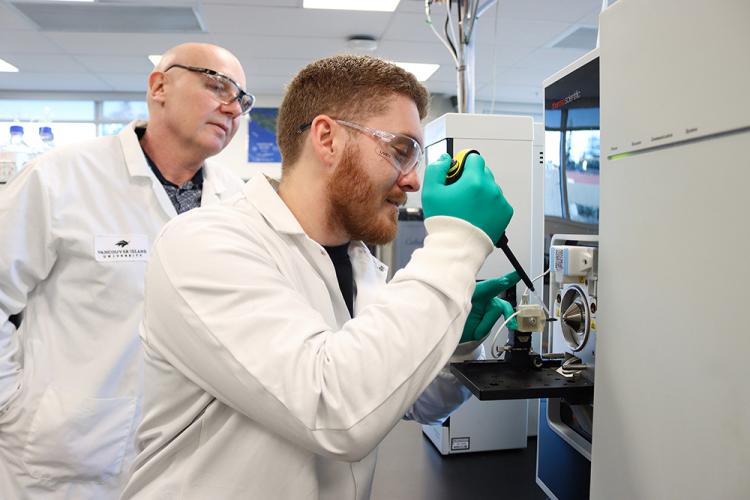In many freshwater bodies across Canada, climate change is causing more frequent blooms of cyanobacteria, also known as blue-green algae, some of which can produce potentially deadly toxins harmful to human and animal health.

Lucas Abruzzi and Dr. Chris Gill introduce a sample to a mass spectrometer for analysis. (Photo Credit: Vancouver Island University photo)
"As global warming has increased, the prevalence of these blooms has also increased, and they threaten access to safe drinking water supplies as well as recreational opportunities across Canada," said Dr. Chris Gill, a VIU Chemistry Professor and Co-Director of Vancouver Island University's (VIU's) Applied Environmental Research Laboratories. "The risk to human health is significant: dogs and wildlife have died from the effects of water contaminated with these toxins."
VIU researchers Gill and Lucas Abruzzi, one of his master's students, are developing revolutionary techniques using paper spray mass spectrometry to measure these toxins in less time and at a lower cost than traditional measurements. They are collaborating with the National Research Council (NRC) of Canada's Halifax lab on the project.
"The possibility of rapidly measuring cyanotoxins directly from water samples using paper spray could transform the way testing is done across Canada particularly in remote communities where it can be cost-prohibitive to ship large water samples away for testing," said Dr. Daniel Beach, a research officer with the Biotoxin Metrology lab at NRC in Halifax.
Gill said cyanobacteria were some of the earliest organisms on the planet, and they can produce a range of toxins referred to as cyanotoxins. The researchers are testing for three different classes of cyanotoxins including microcystins, nodularin and anatoxins. Gill said current measurement methods for cyanotoxins are time-consuming and costly, so many jurisdictions rely on less reliable techniques such as cell counts and visual observation of blooms to protect public health. Without measuring toxins directly, closures could occur unnecessarily in waterbodies with safe levels of toxins. More importantly, unsafe toxin levels could be missed, leading to potential human or animal exposures.
On Vancouver Island, lakes such as Elk Lake, Thetis Lake and Prior Lake can have persistent cyanobacteria blooms and can be closed for months, said Gill, adding that just because you don't see algae blooms doesn't mean there aren't any toxins present.
"Most of our drinking water is relatively unthreatened here in BC, but if you move inland to Alberta, Saskatchewan and Manitoba, their drinking water often comes from shallow lakes. Shallow lakes are great places for algae to grow," said Gill.
"You can't necessarily tell if toxins are present just by looking at a lake. Sometimes the bloom isn't on the surface. A lake could look clear and safe but there could still be toxins present," said Abruzzi. "Different areas of a lake could also have varying levels of bloom, so the toxin isn't always universally dispersed. The only way to compensate for this is through more frequent and widespread testing."
With the paper spray mass spectrometry method the researchers have developed, a tiny volume of water sample (a fraction of a drop) is transferred to a strip of paper and introduced directly into the mass spectrometer for measurement. Results are obtained within two minutes without any sample preparation, as compared to up to 30 minutes per sample for conventional techniques, which also require extensive sample preparation.
"That's why it's revolutionary, there's very little sample preparation," said Gill. "The method also offers the potential of drying samples collected at remote sites on paper strips. Those dried strips can be shipped easily in the mail for analysis, whereas if you're collecting a water sample, it must be transported on ice, making it expensive and cumbersome to send for analysis."
VIU's lab has been working on paper spray mass spectrometry methods since 2014 and developing methods to measure algal toxins for the past three years. Gill said part of the goal is to develop methods to miniaturize the technology so it can go where conventional methods can't.












